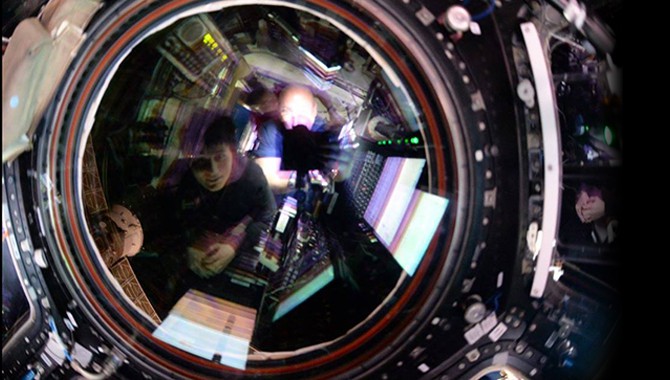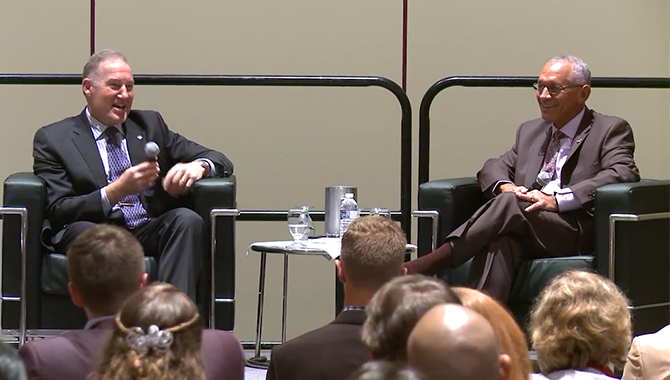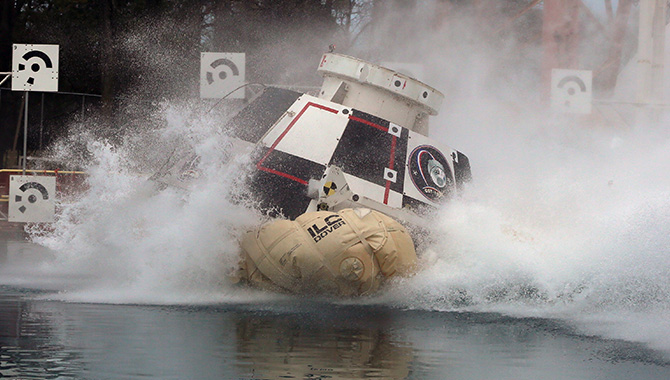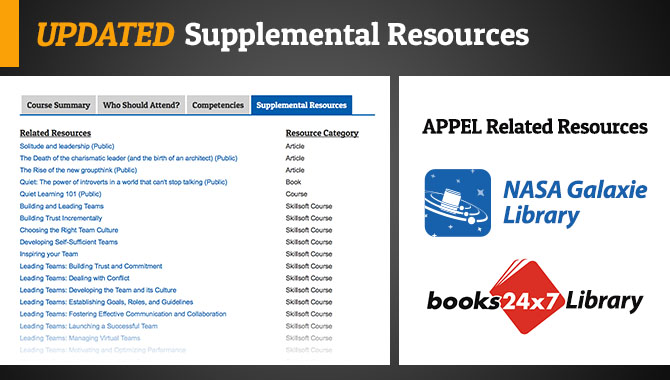
Astronaut Scott Kelly, currently spending 12 months on the ISS as part of the novel One-Year Mission, snapped this image of the SpaceX Dragon cargo craft docking with the space station. ESA astronaut Samantha Cristoforetti is also visible.
Photo Credit: NASA
Renowned as a unique research platform for issues affecting human spaceflight, the applications of the International Space Station (ISS) continue to expand.
The ISS is best known as a state-of-the-art research facility focused on long-duration spaceflight. It also serves as a space-based laboratory that has returned scientific discoveries supporting a range of disciplines, including earth science, human health, and space-related technologies. But as participants in the fourth annual ISS Research and Development Conference (ISSRDC) made clear, the actual applications of the space station are even broader.
Mary Lynne Dittmar, a member of the National Research Council Human Spaceflight Committee, said, “The ISS is a singular engineering achievement, but it’s also an international collaboration on a grand scale. It’s a scientific research platform exploiting a unique physical environment. It’s an evolving technology test bed for space and terrestrial applications. And, importantly, it is an anchor tenant, a nexus of activity fostering a commercial sector in low Earth orbit. At the same time, it serves as a stepping off point for humanity’s journey into the solar system.”
Since its inception, global cooperation has been a key feature of the ISS. Speaking at the 2014 International Astronautical Congress in Toronto, Canada, NASA Administrator Charlie Bolden said, “I always call the ISS a space-born United Nations.” He added that the international partnership that supports the ISS—between NASA, the Russian Federal Space Agency (Roscosmos), the Japan Aerospace Exploration Agency (JAXA), the European Space Agency (ESA), and the Canadian Space Agency (CSA)—“is one of the best examples that we have today about how the world should be and how it can be when people are willing to put themselves second and work on a common goal for the good of humanity.”
Today, stakeholders in the ISS include the space agency community and many others. At the ISSRDC, Mark Sirangelo, head of Sierra Nevada Corporation’s Space Systems, talked about the enormous impact the ISS has had on the burgeoning commercial space industry.
“The thing that really drove a lot of us was the idea that there was a place to go to, there was a reason to move, and there was something that anchored our passion and our dreams,” he said, reflecting on the early days of the industry. “And for us, the anchor for that was the International Space Station.”
His words reinforce the multi-faceted role of the ISS today. “All through the history of development, we’re seeing this is not only a platform for science and a platform for people like me who have a dream and want to go somewhere, but it’s also a platform for global cooperation.” He added, “’[W]e’re going to change the world by the research [conducted] there.”
Robert Ferl, director of University of Florida’s Interdisciplinary Center for Biotechnology Research and contributor to space biology research on the ISS, echoed Sirangelo’s conviction. “The International Space Station is absolutely key to continued scientific interest and exploration of space—and understanding the way things are on Earth.”
The enormous contribution made by research conducted on the ISS is highlighted in a recent book from NASA, International Space Station: Benefits for Humanity. In 2005, the U.S. section of the ISS was tapped to perform a dual function, providing a platform for NASA’s research while simultaneously serving as a National Laboratory hosting scientific experimentation by other federal agencies, private corporations, and academia.
ISS research touches on many diverse areas that affect people on Earth. Human health—from robotic technologies that advance surgical capabilities to sensor technologies that aid ground-based firefighters—is a key area of focus, but the work on the ISS also supports environmental observations and enhances Earth-based disaster response. In addition, ISS research drives technological innovations ranging from improvements in water purification efforts to advancements in transportation technology.
The unique platform benefits both tomorrow’s leaders and today’s. Many experiments are deliberately designed to involve and inspire the next generation of students to engage with science, technology, engineering, and mathematics. At the same time, the ISS plays a critical role in the economic development of low Earth orbit (LEO), providing a destination and proving ground for commercial space endeavors and commercial research initiatives.
Given everything that has been—and continues to be—accomplished on the ISS, its role in advancing understanding in space and on Earth cannot be underestimated.
“It’s a tremendous facility we have on orbit—I don’t think there will ever be another facility like the space station,” said William Gerstenmaier, NASA Associate Administrator for the Human Exploration and Operations Mission Directorate (HEOMD). Considering its future, he added, “[W]e need to bring the space community together with the entrepreneurial community, expose them to a new environment, challenge them, and make the space station an innovation accelerator.” As evidenced at the 2015 ISSRDC, the ISS remains in great demand as a resource for exploration and innovation that benefits humankind in orbit and on the ground.
Visit the ISS Benefits for Humanity website to explore the new book, which was released at the 2015 ISSRDC.








